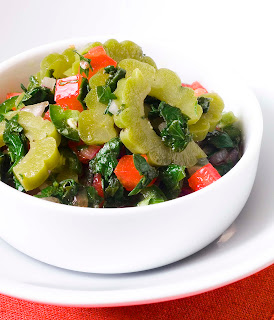 |
| Quick Bitter Melon Salad |
I began to write this a couple of days ago, when I got side-tracked by a competing element (sweet), and ended up writing about agave nectar. Now, starting again, I’m thinking about how that derailment happened. It seems to be human nature to seek out sweetness, not only as in the taste of food, but as in all good feelings. We use the word “sweet” for a number of things unrelated to food–a sweet tune, a sweet person, a sweet deal, the sweet life–yet they all relate to the enjoyable sensation we get when certain foods enter our mouth and trigger the sweet receptors among our taste buds.
Of the four tastes we’re supposedly limited to (unassisted by the olfactory sense), sweet is the only one that reliably elicits a smile. I suspect that this is a bit of evolutionary programming, left over from a time in our distant past, when we began to associate sweetness in food with energy. Glucose is metabolic fuel, so it would make sense that over time we would come to strongly favor sugar-laden foods. Mother’s milk is sweet, so we may associate sweetness with comfort, safety, and connection for that reason alone. It’s hard to say which came first, the biological benefit or the pleasure, but if I’m right about this, then it would also make sense that millennia down the road, we associate deeply enjoyable feelings with a sweet taste.
There are two important variables today that were not part of the equation way back when this predilection was being engraved in the nature of our species: 1) our relative inactivity in relation to the amount of food we currently consume, and 2) our ability to isolate, concentrate, and synthesize sweetness–in great quantities. So, since humans are obviously still eager to be eating sugary foods, and are not having to do much of anything physical to get a ton of them, it’s not a stretch to see why a lot of humans are getting fat, sick, and slow. It’s the old “burn it or wear it” law.
Of course, there are associations with the other three tastes, sour, salty and bitter, and interestingly enough, they’re all are regarded as the opposite of sweet. As a cook, I’m always trying to design food that will bring these elements into balance, while allowing each to sound its particular note. To do this, I’ve had to go out on on the individual limbs of sour, salty, and (especially) bitter, as far as I can reach, to see what they are and how much of their intensity can be tolerated– either unmitigated by sweetness, or unenhanced by some fragrance. What I’ve found is that each taste has a story to tell, and a benefit to offer, but none more fascinating than what we call bitter.
In plants, a bitter taste functions as a line of defense against foraging critters (presumably looking for the same sweet taste humans are after). For example, the skins of most fruits, seeds and vegetables are quite bitter compared with their inner flesh–who would imagine that under an orange’s off-putting pith would reside such an addictive succulence? But for human beings, bitterness in plants can signal something else: medicine. Bitter herbs have been used for thousands of years to cure illnesses, especially those brought on by dietary indiscretions. Bitter herbs, drinks and tinctures can stimulate appetite, aid digestion, and mitigate the unpleasant effects of overindulgence. Most bitter foods are potent blood purifiers and tonics. Bitter is good.
Great, you’re probably thinking, so foul-tasting stuff is good for you. Not what you want to hear, I know, but bear with me. If you’ve had a chance to check out my website, you may have seen what I’m currently using as my manifesto, a piece called “Eat What You Love and Health Will Follow.” Essentially, what I propose is that in order to get the most out of food, health, and indeed life, it’s in our best interest to fall in love with everything that benefits us, not just the stuff that’s sweet on the surface. We can overcome the DNA-deep addiction to a single taste and find pleasure in all of them. It can be done. I’m here to help!
On your first foray into the wild world of bitter vegetables, you might want to start with a middle-of-the-road item like Belgian endive or radicchio. Then again, you may have already gone there, considered it no great shakes, and are ready for a serious adventure. If so, then let me introduce my favorite of all the bitter guys–one you’ll either come to love, or hate forever: bitter melon. Believe me, it can grow on you, once you get over the initial shock. After this, you’ll be a bitter food initiate. Try it! Below is a recipe from my book, Omega 3 Cuisine, which you can simplify your first time out by omitting the fresh fenugreek.
 |
||
| This picture shows Chinese bitter melon and fenugreek. |
.






I love that you posted a healthy recipe for bitter melon! However, would you be able to post a pic of fresh fenugreek, so I’ll recognize it when I go to my local Indian grocery?
Thanks! Next time I see some healthy methi at the Indian store, I’ll do that–good suggestion! They usually get fresh produce on Thursdays, but winter is unpredictable for this item.
or you can use google?
Actually, I did follow up on this post, with a picture of methi. You can check it out here: http://veganascent.blogspot.com/2011/03/fresh-fenugreek.html